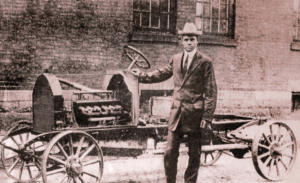Frederick Patterson facts for kids
Quick facts for kids
Frederick Douglas Patterson
|
|
|---|---|
| Born | September 17, 1871 Greenfield, Ohio, US
|
| Died | January 18, 1932 (aged 60) |
| Other names | Fred Patterson |
| Employer | C.R. Patterson and Sons |
| Known for | First African American car manufacturer |
| Children | 2 |
| Parent(s) |
|
Frederick Douglas Patterson (1871 – 1932) was an American businessman and inventor. He was famous for taking over his family's company, C.R. Patterson and Sons. He also created the Patterson-Greenfield car in 1915. This made him the first African American to own a car manufacturing company.

While at Ohio State University, Frederick was the first African American to play on their football team. After college, he joined his father's carriage business in Greenfield, Ohio. He saw a chance to make new "horseless carriages," which we now call cars. In the early 1900s, he changed the company to build automobiles. Later, he started making buses and trucks. He then renamed his company the Greenfield Bus Body Company.
Contents
Early Life and Education
Frederick Douglas Patterson was born in 1871. He was named after the famous abolitionist Frederick Douglass. Frederick was one of five children. His parents were Josephine Utz and Charles Richard Patterson.
His father, Charles, was a former slave. He moved to Greenfield, Ohio from Virginia before the American Civil War. Charles became a blacksmith in town. He later married Josephine Utz. In 1873, Charles and a white carriage maker, J.P. Lowe, started a successful business. It was called J.P. Lowe & Company.
Frederick's parents cared a lot about education. Frederick finished Greenfield High School in 1888. He then went to Ohio State University. In 1891, he played on the university's football team. He was the first African American to do so. Frederick left college before graduating. He became a high school history teacher in Louisville, Kentucky. His brother, Samuel, was already working in their father's business.
Leading the Family Business
Frederick Douglas Patterson took over the family business in 1910. This was after his father passed away. He saw that "horseless carriages" were becoming popular. So, Patterson started to develop his own car.
The first Patterson-Greenfield car was finished in 1915. He made two styles of cars. They sold for $685. This was a similar price to Henry Ford's Model T. Patterson was the first African American to own and run a car manufacturing company.
His company made between 30 and 150 cars. But it was hard to get money to grow the business. Patterson decided not to compete directly with the big car companies in Detroit.
In 1920, he changed his company's name. It became the Greenfield Bus Body Company. He started building bodies for trucks and buses. Other companies made the chassis (the frame and engine). The Great Depression hit his company hard. Many customers stopped ordering buses because of money problems. Patterson died in 1932. His son, Postell Patterson, had worked with him. Postell closed the business in 1939.
Today, no Patterson-Greenfield cars are known to still exist. However, some of his father's old carriages have survived. Patterson is featured in the TV show Profiles of African-American Success.
Personal Life and Community Involvement
Family and Beliefs
Patterson got married in 1899. He had two sons, Frederick Postell Patterson and Postell Patterson.
He was a Methodist. He also joined the Freemasons, a fraternal organization. He became a high-ranking member in his local lodge. Patterson also joined the Third Wind Foraker club.
Political Activities
Patterson became the second vice-president of the National Negro Business League. This was when Booker T. Washington was its leader.
He was a member of the Republican Party. He served as a delegate for Greenfield at the Ohio Republican Party meetings. As an African-American businessman and delegate, he was important in politics. He helped get African-American votes for Warren G. Harding's 1920 campaign. Because of his work in that election, he became an alternate delegate. This was for the 1924 Republican National Convention.

